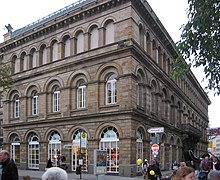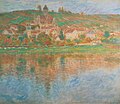| This article needs additional citations for verification. Please help improve this article by adding citations to reliable sources. Unsourced material may be challenged and removed. Find sources: "Von der Heydt Museum" – news · newspapers · books · scholar · JSTOR (September 2014) (Learn how and when to remove this message) |
 Von der Heydt Museum Von der Heydt Museum | |
| Interactive fullscreen map | |
| Location | Wuppertal, Germany |
|---|---|
| Coordinates | 51°15′26″N 7°8′48″E / 51.25722°N 7.14667°E / 51.25722; 7.14667 |
The Von der Heydt Museum is a museum in Wuppertal, Germany.
The Von der Heydt Museum includes works by artists from the 17th century to the present time.
History
The museum is housed in the former city hall of Elberfeld, which in 1902 became a municipal museum.
The museum was named in 1961 after the Von der Heydt family. Banker August von der Heydt and his son Eduard von der Heydt (1882–1964) were important patrons.
Notable works
Gallery
-
 Carl Spitzweg, Der Geologe, 1855/60
Carl Spitzweg, Der Geologe, 1855/60
-
 Hans von Marées, Porträt Adolf von Hildebrand, around 1868
Hans von Marées, Porträt Adolf von Hildebrand, around 1868
-
 Claude Monet, Vétheuil, around 1901
Claude Monet, Vétheuil, around 1901
-
 Edgar Degas, Tänzerinnen im Probensaal, 1891
Edgar Degas, Tänzerinnen im Probensaal, 1891
-
 Paul Cézanne, Die eremitage in Pontoise, 1881
Paul Cézanne, Die eremitage in Pontoise, 1881
-
 Paul Gauguin, Stillleben mit exotischen Vögeln II, 1902
Paul Gauguin, Stillleben mit exotischen Vögeln II, 1902
Directors
- 1902–1929: Friedrich Fries (1865–1954)
- 1929–1952: Victor Dirksen (1887–1955)
- 1953–1962: Harald Seiler (1910–1976)
- 1962–1985: Günter Aust (1921–2018)
- 1985–2006: Sabine Fehlemann (1941–2008)
- 2006– 1 May 2019: Gerhard Finckh (born 1952)
- since 1 April 2020 Roland Mönig (born 1965)
Notes and references
- "Von der Heydt-Museum". Retrieved 24 October 2019. (in German)
External links
- Official website—(in German)
This article about a museum in Germany is a stub. You can help Misplaced Pages by expanding it. |
This article about a North Rhine-Westphalian building or structure is a stub. You can help Misplaced Pages by expanding it. |